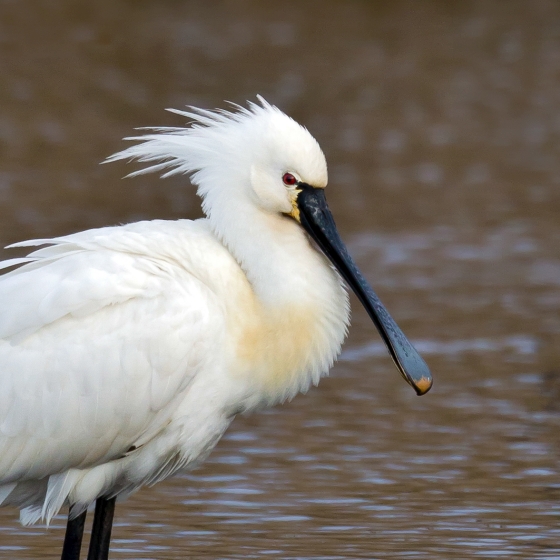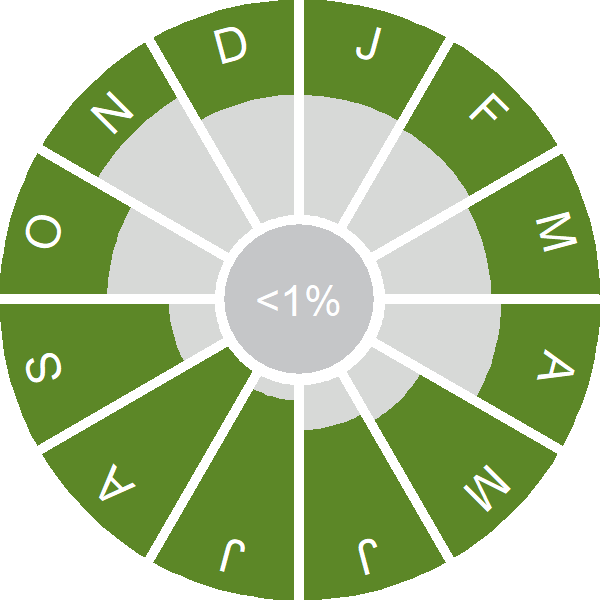Spoonbill

Introduction
Spoonbill is one of a number of species expanding their breeding range northwards as a result of climate change, and the species is becoming a more familiar sight to birdwatchers.
Spoonbills breed in very small numbers at just a handful of locations in England, the most successful of which is a colony on the north Norfolk coast. Spoonbills tend to breed in mixed colonies, alongside herons and inland-breeding Cormorants. In summer plumage the yellow tip to the adult's spoon-shaped bill and the crest plumes make this a very attractive bird.
Atlas data highlight the current southerly distribution in Britain & Ireland, particularly evident in the winter months.

Key Stats
Status and Trends
Conservation Status
Population Change
Spoonbill bred in southern England until the 17th century and has successfully re-colonised the UK over the course of the last decade, following on from the first successful modern-day breeding attempt in 1999 (Ogilvie et al. 2001). The main stronghold of the species is at Holkham in Norfolk where breeding first occurred in 2010 and the number of breeding pairs had risen to 28 in 2020 (Bloomfield 2021). Since the establishment of the colony at Holkham, breeding has occurred at several other sites across the UK.
Distribution
Spoonbill is a rare breeding bird in Britain. At the time of Bird Atlas 2007–11 breeding was confirmed in two 10-km squares, in Dumfries & Galloway and in Norfolk. They are widely distributed in winter across a range of mostly coastal sites in southern Britain.
Occupied 10-km squares in UK
or view it on Bird Atlas Mapstore.
or view it on Bird Atlas Mapstore.
European Distribution Map
Distribution Change
Change in occupied 10-km squares in the UK
or view it on Bird Atlas Mapstore.
or view it on Bird Atlas Mapstore.
Seasonality
Spoonbill was formerly a scarce summer visitor, but is now an expanding breeder and can also be seen throughout the winter at some southern locations.
Weekly pattern of occurrence
The graph shows when the species is present in the UK, with taller bars indicating a higher likelihood of encountering the species in appropriate regions and habitats.

Movement
Britain & Ireland movement
Foreign locations of birds ringed or recovered in Britain & Ireland
Dots show the foreign destinations of birds ringed in Britain & Ireland, and the origins of birds ringed overseas that were subsequently recaptured, resighted or found dead in Britain & Ireland. Dot colours indicate the time of year that the species was present at the location.
- Winter (Nov-Feb)
- Spring (Mar-Apr)
- Summer (May-Jul)
- Autumn (Aug-Oct)

European movements
EuroBirdPortal uses birdwatcher's records, such as those logged in BirdTrack to map the flows of birds as they arrive and depart Europe. See maps for this species here.
The Eurasian-African Migration Atlas shows movements of individual birds ringed or recovered in Europe. See maps for this species here.
Biology
Productivity and Nesting
Nesting timing
Egg measurements
Clutch Size
Survival and Longevity
Survival is shown as the proportion of birds surviving from one year to the next and is derived from bird ringing data. It can also be used to estimate how long birds typically live.
View number ringed each year in the Online Ringing Report.
Classification, names and codes
Classification and Codes
- Order: Pelecaniformes
- Family: Threskiornithidae
- Scientific name: Platalea leucorodia
- Authority: Linnaeus, 1758
- BTO 2-letter code: NB
- BTO 5-letter code: SPOON
- Euring code number: 1440
Alternate species names
- Catalan: becplaner comú
- Czech: kolpík bílý
- Danish: Skestork
- Dutch: Lepelaar
- Estonian: luitsnokk-iibis
- Finnish: kapustahaikara
- French: Spatule blanche
- Gaelic: Gob-leathann
- German: Löffler
- Hungarian: kanalasgém
- Icelandic: Flatnefur
- Irish: Leitheadach
- Italian: Spatola
- Latvian: karošknabis
- Lithuanian: paprastoji girnove
- Norwegian: Skjestork
- Polish: warzecha (zwyczajna)
- Portuguese: colhereiro-europeu
- Slovak: lyžiciar biely
- Slovenian: žlicarka
- Spanish: Espátula común
- Swedish: skedstork
- Welsh: Llwybig
Research
Causes of Change and Solutions
Causes of change
The re-colonisation of the UK follows a range expansion across Europe. The reasons for this are unclear although it is possible that climate change may have been a factor. In the Netherlands, it has been suggested that local population growth may have levelled off at some sites as a result of density dependent effects caused by limited food supply (Oudman et al. 2017), which may potentially be a driver of the ongoing range expansion.

